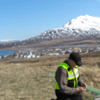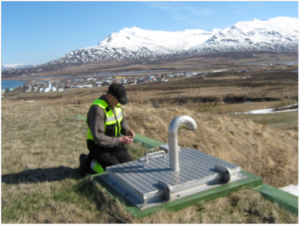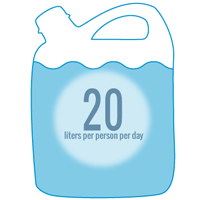

Manhole on a drinking water storage tank for the Town of Dalvik, North Iceland (photo: Gunnarsdottir)
Safe drinking water is essential for the health of all people and ensuring safe water at the national level requires a framework comprised of regulation and responsible actors. A new analysis of the current national framework in Iceland explores the interplay between various safe drinking water actors on a national level was recently published in the International Journal of Hygiene and Environmental Health. The analysis classifies regulators according to their roles in addressing drinking water quality, water protection and health. The associated legislations are listed and discussed and the role of the responsible actors are examined. The legislative environment for the water suppliers is also explored. Iceland’s water safety framework is mostly in place. While the analysis identifies measurable successes, there are ongoing challenges to addressing the multi-faceted aspects of ensuring a safe water supply.
Challenges
The main challenges include the need for improved guidance in operating a water safety plans (WSP) at water utilities, especially at the smaller utilities. A lack of systematic external audit and surveillance of these plans slowed further development of the WSP. The analyses demonstrated a need to revise the current drinking water regulation in light of the experience gained since it was implemented roughly 10 years ago. These include issues like roles and responsibility in daily operations as well as maintenance and define more clearly what a regulated water utility is. Communication to the general public was in many cases found lacking, both with regard to incident reporting as well as general information about the drinking water and compliance.
Water Safety Planning in Iceland
Iceland is a water-rich nation on a per capita basis. A challenge in water management for Iceland is not in providing water quantity, but in ensuring safe water quality for the population, which is dispersed throughout the country in relatively small localities.
95% of drinking water for Iceland’s population (approx. 320,000) comes from groundwater. Iceland does not treat or practice residual disinfection of groundwater, so preventive management and strong water catchment protections are vital for safe water. Iceland has had preventive management of water supply as a legal requirement since 1995 when drinking water was defined as food in the Foodstuffs Act. Iceland has incorporated European water directives into the Icelandic regulatory environment: the Drinking Water Directive through updated Icelandic Drinking Water Regulation (2001) and the Water Framework Directive (2012).
There are 49 water supply systems in Iceland that serve more than 500 inhabitants. Of these, 23 have a WSP in place, as legally required since 1995, and an additional eight smaller utilities also have a WSP in place, in total serving 81% of the population.
Several of the challenges can be linked to a need for additional training or increases in other resources required to implement monitoring and enforcement. For instance, while guidelines call for surveillance of water intake and system status, the smaller water utilities lag behind larger utilities in monitoring water supply status.
Success
The analysis showed that most of the legal requirements are in place, both at the institution level and at the municipal level and are mostly functional. The analysis indicated a considerably success in providing safe water to the general public. A previous 2012 study found that implementation of WSPs in localities reduced the occurrence of e. coli detections and instances of diarrheal disease.
The water utilities that have implemented water safety plans experience a positive impact on the utility culture, improved compliance to regulation, and enhanced public health.

